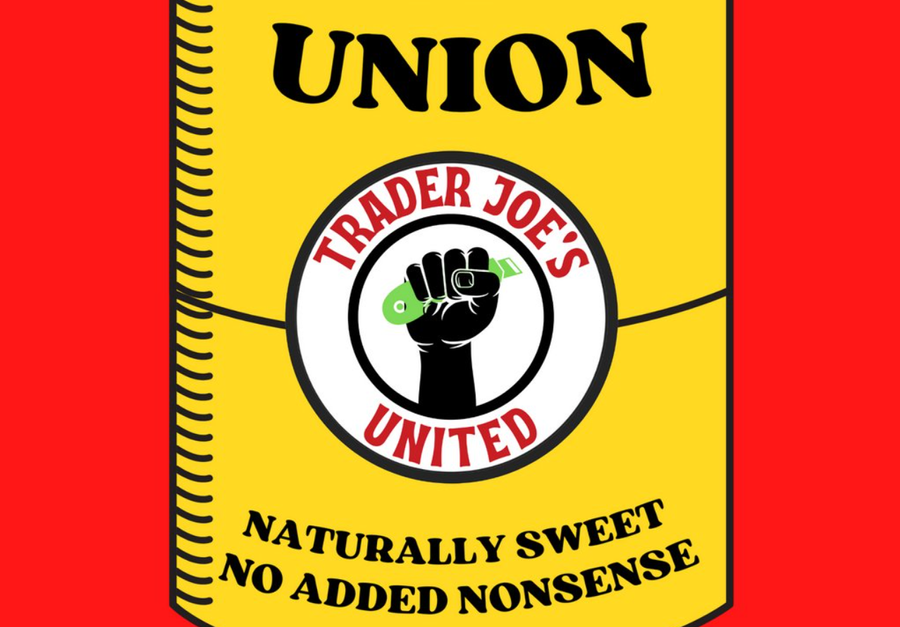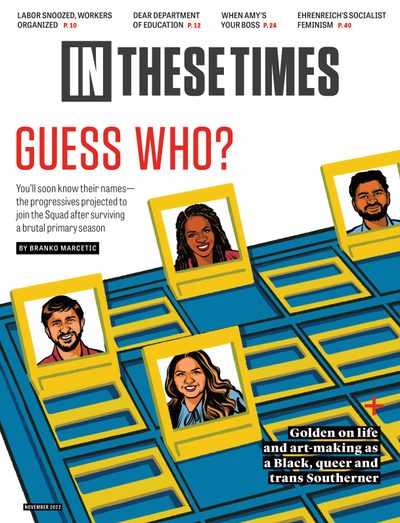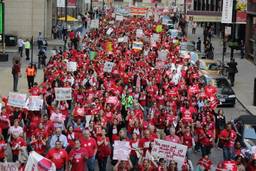Independent Unions Are Great—And Proof of Labor's Broken Institutions
The inspiring wave of independent labor organizing also represents the failure of existing unions.
Hamilton Nolan

This year has brought a lot of stirring labor victories, a pace of union campaigns and strikes so frenetic that it’s easy to collapse in a puddle of undifferentiated cheering for stuff. The most important trend, though, has been the sudden rise of independent unions — organizing drives at untouched companies led by the workers themselves, not affiliated with any existing major unions. The Amazon Labor Union (ALU) has been the biggest example of those, and an endless stream of others seem determined to follow in its footsteps. An independent union drive succeeded at Trader Joe’s, and they’ve popped up everywhere from Apple to Chipotle to Geico. Geico!
The rise of all of these independents is inspiring. It is the flowering of seeds that were planted by 40 years of rising inequality, and by the work of an entire generation of labor movement activists pushing unions as the solution. If we are being honest, though, the story of these independent unions is also a story about the brokenness of organized labor’s existing institutions. If we ignore half of the story, we won’t learn anything from this moment.
One thing that virtually every independent union that’s popped into being this year has in common is this: They are at places that should have been unionized a long time ago. I don’t just mean that in the generic sense of “all workplaces should have a union.” I mean that if America had a union movement with even a modicum of ability to do strategic planning on a national level, the big unions that already sit in these respective industries would have been working hard to build campaigns at many of these companies years ago.
United Food and Commercial Workers (UFCW), for example, is the grocery industry union. It should have been plainly obvious a decade ago, at least, that Trader Joe’s was a prime target: a successful, growing national grocery chain that also carried with it a cultivated reputation for caring about employees, as well as the community and social justice. That is the absolute pinnacle of “characteristics of a company that should be a union organizing target.” The fact this country’s first Trader Joe’s union election happened in the year 2022 and was organized by workers themselves is a pretty harsh rebuke to the UFCW, which represents 835,000 grocery workers and has more resources than all but a handful of other unions.
Amazon? Apple? Chipotle? Geico? All of these are premier employers in industries that have existing unions. (In many cases, the existing unions have organizing drives at these companies themselves too: Communications Workers of America (CWA) is organizing Apple stores, and a Chipotle unionized with the Teamsters, and the Retail, Wholesale and Department Store Union (RWDSU) is still deeply engaged at the Amazon warehouse in Bessemer, Alabama, and UFCW is organizing Trader Joe’s — all of which are good examples of the ability of independent drives to energize moribund sectors, or to pick up excess demand where existing unions don’t.) The problem here is not the failure of individual unions, but of an entire union establishment that has for decades accepted the proposition that it’s the responsibility of workers to come ask unions to organize them, not vice versa.
Let us imagine an American labor movement that had 1) A genuine belief that it is the responsibility of unions to offer every worker in their industry a true opportunity to unionize, and 2) A rudimentary level of central organization and accountability that could exert some pressure on unions that weren’t organizing to do a better job. In this fairy tale world, it would still take bravery and hard work and idealism from workers at all of these places to undertake the daunting and uncertain prospect of organizing their workplace for the first time.
The difference is that they would have all had the card of a union organizer in their pocket. Because the unions in their respective industries would have made a strong effort to organize them, and would have made it their business to ensure that all the non-union workers at those companies knew that this union wanted to organize them, so when the stars aligned and the moment arrived when employees were ready to take on the challenge, they quite naturally would have thought of the existing union as their first phone call.
Broadly speaking, that is not what has happened. I say this as someone who has for years now fielded incoming emails from random people asking me how to unionize, and have tried to get them in touch with union organizers from the right unions. It has always been shockingly difficult, especially for the majority of people not lucky enough to be working in the very narrow slices of industries that are already subject to ongoing union drives.
In the past seven years, I’ve tried to help Amazon workers and Trader Joe’s workers and Whole Foods workers and even insurance company workers find a union to help them organize. For the most part, it has been hard to find the right union, hard to find the right organizer at the right union, and very hard to get an overworked organizer at the right union to dedicate a sufficient amount of time to leads like this. There are heroic union staffers everywhere, but not nearly enough of them. The problem is not the individual people — the problem is this sort of thing, which should have always been the top priority of a labor movement that has been losing density for decades, has not been much of a priority at all.
So the pandemic happened, and a tipping point was reached, and there has been a widespread grassroots surge of interest in unionizing, and — surprise! — many workers have come to the conclusion that it makes a lot more sense to organize themselves than to spend forever making calls to existing unions that have never spoken to them before, and have not spent the money to build the organizing staff necessary to give them the time that they need. This makes perfect sense. The hard numbers tell us that America’s biggest unions have allowed their organizing muscles to atrophy, and now that game day has arrived, they are largely too weak to play.
This must be a moment of reckoning for the people who lead unions and control their budgets. As much as we cheer on the resolve of workers who take it upon themselves to organize independently, we must also turn to the unions in their industry and say: ‘Hey, why didn’t you get that?’ I don’t want a bland stream of cheerleading tweets from the AFL-CIO about this trend of independents — I want nonstop meetings of top union leaders cowering in chagrin over how it came to this in the first place.
This moment in history is an unfolding demonstration of the fact that organizing must be a nonstop practice. You cannot just allow it to wilt for decades and then expect to flip it on like a switch when the national mood changes. A recent report found that organized labor in America employed 23,000 less people in 2020 than it did in 2010, even while its bank accounts swelled. How many of those people were potential organizers who could have been sitting in coffee shops or McDonald’s parking lots across the street from Trader Joe’s and Amazon warehouses and dreary white collar office buildings, talking to workers about what a union could do for them? A lot.
Philosophically, there is nothing wrong with having an independent union. Practically, there are many drawbacks: It can take a lot of time and money and expertise and lawyers to get a solid first union contract in place. Those are things that existing unions have that independents don’t. Winning the union vote is great, but only a first step. Unions got big and coalesced in the first place because solidarity is power — and money, and staff, and political connections, and law firms. Many of the independent unions that do manage to win a union election will inevitably migrate towards existing unions over time, or they will get crushed by their multibillion-dollar employers willing to stall and litigate every single thing rather than bargain a fair contract.
So some independents will join bigger unions, and some, like ALU, may manage to grow enough to form their own new unions, and others will die out. But they have done the labor movement a great service no matter what their eventual fate is: They have become big, flashing billboards for the need to invest in institutional organizing capacity, so that no working person is ever unable to find a union that would like to help them organize. If we don’t say that out loud, the lesson will be ignored. Strong unions knock on every door. They talk to every worker. They bring the message to people who don’t even know they need it. They don’t sit inside while the times are tough, and come out when it’s sunny to find that the big game started without them.
Hamilton Nolan is a labor writer for In These Times. He has spent the past decade writing about labor and politics for Gawker, Splinter, The Guardian, and elsewhere. More of his work is on Substack.









